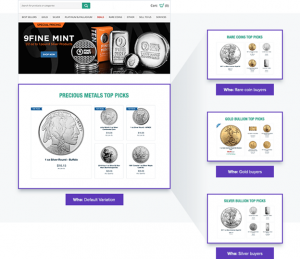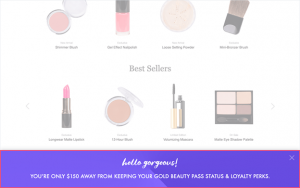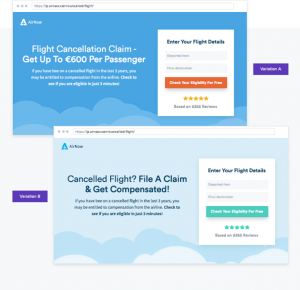עסקים שביקשו בעבר להשיג נוכחות במדיה הדיגיטלית היו צריכים לפתח אתר ראוי, לפרסם תוכן מעניין ועדכני, להשקיע בצורה חכמה באופטימיזציה למנועי חיפוש (SEO), לקדם לפרסם ולשווק באמצעים שונים כגון פרסום (PPC), ניהול מדיה חברתית ודיוורים על מנת למשוך את הצרכנים. אך ככל שהתחרות על תשומת ליבו של הצרכן גוברת, העלות של השגת לקוחות באופן זה נעשה יקר ולא יעיל.
כלים לביצוע מבחני השוואה (A/B testing) סייעו למשווקים להבין איזה מהאפשרויות להעברת מסרים תספק חווית משתמש יעילה יותר ותשיג שיפור באחוזי ההמרה (conversion) וזאת על ידי ביצוע אופטימיזציה של רכיבים באתר.
אולם כיום, כאשר מדובר על קרוב ל-2 מיליארד אתרים בעולם ומספר הולך וגדל של ערוצי מדיה דיגיטליים נוספים המשולבים במסע הלקוח, זה כבר לא מספיק. מותגים ומשווקים שרוצים להשפיע חייבים להשקיע בפרסונליזציה ולתקשר עם הצרכנים שלהם באופן מותאם לכל אחד ואחת מהם.
מהי פרסונליזציה?
בעבר פרסונליזציה התבטאה בהצגת שם המשתמש או הלקוח באתר או בדיוור על ידי ממשק למערכת ה-CRM הארגונית. בהמשך נעשה שימוש בכלים שונים ליצירה של סגמנטים של לקוחות ועל פי מאפייני הלקוח לשייך אותו לסגמנט ולהציע לו הצעות ערך התואמות לסגמנט אליו שויך. וזאת הייתה טקטיקה די נפוצה, אך לא נתנה את התוצאות הרצויות כיוון שמשתמש, לקוח פוטנציאלי עשוי להתנהג אחרת במצבים ובאמצעי מדיה שונים. כיום פרסונליזציה היא דיסציפלינה בפני עצמה – המקיפה ערוצים, אסטרטגיות וצוותים.
Businesses that previously wanted to gain presence in digital media had to develop a decent website, publish interesting and up-to-date content, invest wisely in search engine optimization (SEO), promote, advertise, and market through various means such as advertising (PPC), social media management, and newsletters to attract consumers. However, as competition for consumer attention increases, the cost of acquiring customers in this way becomes expensive and inefficient.
Tools for conducting comparison tests (A/B testing) helped marketers understand which message delivery options would provide a more efficient user experience and improve conversion rates (conversion) by optimizing elements on the website.
However, today, with nearly 2 billion websites globally and an increasing number of digital media channels integrated into the customer journey, this is no longer enough. Brands and marketers who want to influence must invest in personalization and communicate with their consumers in a way that is tailored to each individual.
What is Personalization?
In the past, personalization was reflected by displaying the user or customer’s name on a website or in a newsletter via an interface with the organizational CRM system. Later, various tools were used to create customer segments, and based on customer characteristics, assign them to a segment and offer value propositions that matched the segment. This was a fairly common tactic but did not provide the desired results because a user or potential customer may behave differently in different situations and media. Today, personalization is a discipline in itself – covering channels, strategies, and teams.
Real-time personalization is the process where the experience provided to the user or potential customer is one-to-one (one-to-one) rather than one-to-many (one-to-many). Instead of targeting the “average user” or focusing on correlations between groups as done in segmentation, personalization provides dynamic responses to each customer’s personal needs, thereby increasing the relevance of the communication.
The Main Benefits of Personalization on Websites
Some think personalization is a passing trend. However, studies show that consumers appreciate being recognized as individuals and tend to purchase more from companies that tailor the experience to them. In a survey conducted among 3,000 consumers, 63% indicated that personalization is a service they expect to receive.
Website visitors are different from each other; each has their own interests, desires, and motivations. For this reason, marketers turn to personalization to predict and respond to customer needs, a practice that has become the standard (according to a survey by Gartner – 14% of marketing expenses are for personalization efforts). Moreover, according to a study by Accenture, 91% of consumers tend to buy from stores that provide relevant offers and recommendations.
Challenges in Implementing Real-Time Personalization on Websites
Personalization is difficult to implement, but doing it correctly will differentiate you from your competitors and give you a significant advantage. Some of the problems that previously challenged those wanting to implement personalization can now be solved:
- Data Challenges: Today, data from many sources can be integrated so the customer receives combined, tailored information.
- Cost: Engines that generate patterns and improved workflows for designing customized campaigns save on development resources that were previously required.
- Scalability Issues: Due to the many options and combinations, it was almost impossible to choose a winning variation against a changing customer base. Advanced platforms include machine learning and AI technologies that enable optimization and automation of processes that were previously done manually.
Basic Elements Needed to Begin the Personalization Process for a Website
There are several basic elements that anyone looking to implement personalization needs:
- Unified Data Set. There must be the ability to capture information from many sources to create a unified data set based on events, actions, and important behaviors at each touchpoint. It is advisable to consider replacing several point solutions with a multi-channel personalization platform, enabling data to flow easily and serve as a basis for creating meaningful, personal experiences.
- Open Architecture. Integration with other marketing tools, regardless of the vendor, should be transparent to support use cases effectively. High flexibility can reduce development time and generate profits by accelerating the business’s expansion process.
- Decision Logic. Automation of analysis and display processes is essential to improve efficiency, expand operations, and ensure that each customer receives the optimal experience. As the number of tests, variations, and segments increases over a series of experiments, it becomes very difficult to evaluate the impact, and this is something that can only be improved through machine learning.
Types of Data Used for Personalization on Websites
There are many types of data that can be used to ensure the right experience for the right user at the right time. Combining many information sources allows for highly accurate personalization according to different variables. On the other hand, using too much data and too many variables will make it difficult to analyze the information and create personal scripts.
Examples of variables categorized by main categories:
|
Variable |
Description |
| Location | The country, region, or city where the user is located. |
| Technology | The user’s device type (desktop, laptop, mobile phone, operating system, browser, and even screen). |
| Traffic Sources | The source from which the visitor came – paid or organic, search or social media. |
| Third-party Data | Information collected about the user from external sources and stored in a Data Management Platform (Data Management Platform). |
| Behavior | Important information about the user’s behavior such as clicks, adding to the shopping cart, purchases, page views, URLs visited, etc. |
| Explicit Information | Information collected about the user – from the CRM system or proactively via surveys or registration forms. |
| Time | Dates, days of the week, or time of day when the user interacts with the site. |
| Current Page |
The type of page the user “landed” on – a specific URL, homepage, product details page, or shopping cart. |
Data Sources and Their Importance for Personalization
Data from third-party sources makes up the largest percentage of website traffic (~75%), but it is the least accurate for personalization. Tracking user behavior is the second largest source (~60%) and has medium accuracy, but it is crucial for understanding general browsing patterns on the site and can be used to enhance the experience of anonymous visitors.
Behavioral variables on the site, as identified by algorithms (~30%), and data from the CRM (~15%) are the most accurate, and although they account for a smaller portion of the site traffic, they greatly contribute to improving the experiences of returning and loyal customers.
Real-Time Personalization Implementation on the Website
There are many options for implementing personalization on a website, each addressing a different need. The following types of experiences can be tested, improved, and personalized for each visitor on the site – together, they form powerful tools for improving the overall marketing funnel.
| Experience Type | Use Case |
| Dynamic Content | Main banners on the site, call-to-action buttons, promotional modules, or any other page element with dynamically generated content variations. |
| Recommendations | Displaying content or products based on data, user behavior, or general browsing trends. |
| Layers and Pop-up Windows | Highlighting a special offer via a large, attention-grabbing pop-up window. |
| Messages and Widgets | Displaying subtle, non-invasive elements in the corner of the screen or in the form of sliding windows or floating bars. |
| Messages | Displaying promotional, social, immediate, or action-oriented content across the site. |
| Landing Page | Displaying personalized content for each visitor, instead of a uniform content version for everyone. |
| Menu Personalization | Reorganizing or changing the order of the navigation bar based on the preferences of each visitor. |
| Customized Search | Displaying search results that match the preferences and behavior of users in real time. |
The customer journey is no longer linear and involves many touchpoints, which provides more opportunities to deliver relevant and continuous experiences through personalization – whether the user is in an online store, browsing on a desktop, reading an email, or opening a mobile app.
Examples of Personalization
Here are several examples of how better personalization can be achieved with data.
Homepage and Personalized Recommendations Based on User Interests
In order to display relevant product recommendations, a large retailer of precious metals in the U.S. created audiences based on the data available in the company. Every site visitor receives the most relevant recommendations to them at the top of the homepage.
 Personalization Based on Company Data
Personalization Based on Company Data
Using Customer Club Data to Personalize the User Experience
To increase engagement and reduce website bounce rates, a major cosmetics retailer uses CRM data – information from the customer club (loyalty program) – to provide personalized communication.
 Personalization Based on Customer Brand Interaction
Personalization Based on Customer Brand Interaction
Designing Personalized Landing Pages Based on User Behavior
A leading European airline company customizes each of its landing pages based on browsing history, location, referring campaign, time of day, and other specific user data. The goal is to create a connection with the visitors, which leads to an improvement in conversion.
 Optimization Based on Integrated Data Sources
Optimization Based on Integrated Data Sources
There are many other examples of personalization that contribute to improving conversion, increasing average order value, boosting revenue, and more. The benefits of personalization are clear – according to McKinsey, personalized experiences lead to a 50% reduction in customer acquisition costs, a 5-15% increase in revenue, and a 30% improvement in marketing ROI.
How to Approach Personalization Implementation?
Here are several tips to help you achieve the best results from personalization, both at the beginning and as you continue.
- You don’t need all the data in the world – Many companies mistakenly believe that you need tons of data to do meaningful personalization, but that’s not the case. While having more data helps you understand your audience better, you can relatively easily collect and segment basic data about online behavior to improve the browsing experience. This data will give you a great starting point for personalization.
- Start small – Personalization is a journey, not a destination, and it’s best to start by experimenting with simple elements like the homepage banner, product images on product pages, recommendations strategies, etc. Small, easy-to-implement projects will help you gain the support of management, increase trust in the program, and later you can implement larger-scale personalization.
- Dive into your audience data – After running enough experiments, you can start analyzing the data you’ve collected and find interesting correlations between groups like intent level, common referral sources, or demographic/psychographic data. Your visitors will be able to experience personalization based on significant events, actions, and behaviors over time.
- Use AI for Automation – By using algorithms to continuously gather user data, you can automatically display the best variation for each visitor, regardless of where they came from, what device they’re using, etc. This will streamline the process of delivering personalized experiences and increase accuracy. We use the SALESmanago system for implementing personalization.
- Listen to your audiences – Visitors change over time, so it’s important to constantly update your personalized campaigns to maximize long-term results. You should create and run new tests based on all the available data, and improve existing campaigns to adapt the experience as users change.
Only 25% of companies are implementing real-time personalization!
According to Merkle, only 25% of companies are implementing real-time personalization. 75% of companies still rely on predefined personalization strategies.
Customers today expect personalized attention in digital media as well. Implementing real-time personalization will increase customer satisfaction, conversion rates, sales, and browsing. It’s a continuous process, not a project that starts and ends. It can be implemented in phases, starting with small steps and increasing efforts over time.
For more information on how we advise and implement personalization for our clients with various tools, contact us.



